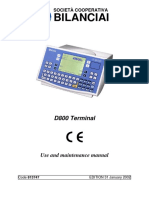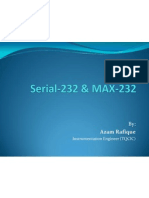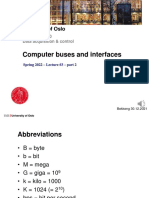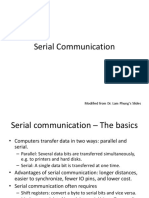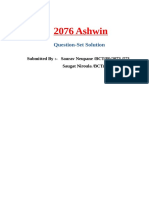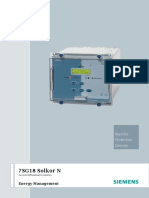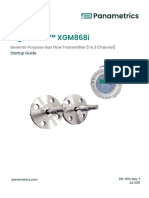0 ratings0% found this document useful (0 votes)
17 viewsDevasi Sir Serial
Devasi Sir Serial
Uploaded by
forloginusethis accountThis document discusses serial vs parallel communication and provides details about serial communication. It covers the basics of serial communication including that it uses a single data line, enabling long distance communication. It describes asynchronous and synchronous serial communication, and discusses data framing, transfer rates, RS-232 standards, and handshaking in serial communication.
Copyright:
© All Rights Reserved
Available Formats
Download as PDF, TXT or read online from Scribd
Devasi Sir Serial
Devasi Sir Serial
Uploaded by
forloginusethis account0 ratings0% found this document useful (0 votes)
17 views18 pagesThis document discusses serial vs parallel communication and provides details about serial communication. It covers the basics of serial communication including that it uses a single data line, enabling long distance communication. It describes asynchronous and synchronous serial communication, and discusses data framing, transfer rates, RS-232 standards, and handshaking in serial communication.
Original Title
devasi sir Serial
Copyright
© © All Rights Reserved
Available Formats
PDF, TXT or read online from Scribd
Share this document
Did you find this document useful?
Is this content inappropriate?
This document discusses serial vs parallel communication and provides details about serial communication. It covers the basics of serial communication including that it uses a single data line, enabling long distance communication. It describes asynchronous and synchronous serial communication, and discusses data framing, transfer rates, RS-232 standards, and handshaking in serial communication.
Copyright:
© All Rights Reserved
Available Formats
Download as PDF, TXT or read online from Scribd
Download as pdf or txt
0 ratings0% found this document useful (0 votes)
17 views18 pagesDevasi Sir Serial
Devasi Sir Serial
Uploaded by
forloginusethis accountThis document discusses serial vs parallel communication and provides details about serial communication. It covers the basics of serial communication including that it uses a single data line, enabling long distance communication. It describes asynchronous and synchronous serial communication, and discusses data framing, transfer rates, RS-232 standards, and handshaking in serial communication.
Copyright:
© All Rights Reserved
Available Formats
Download as PDF, TXT or read online from Scribd
Download as pdf or txt
You are on page 1of 18
Serial Communication
Serial v/s Parallel Communication
Serial v/s Parallel Communication
Parallel Communication Serial Communication
Often 8 or more lines (wire conductors) The data is sent one bit at a time on a
are used to transfer data. Multiple bits single line (wire)
are transferred at a time.
Preferred for short-distance Preferred over long-distance
communication communication
Costly as more resources are required Comparatively cheaper
Speed of data transfer is high Slow
Example: SPI, I2C, UART Example: PCI
Basics of Serial Communication
• Serial communication uses single data line making it much cheaper
• Enables two computers in different cities to communicate over the
telephone
• Byte of data must be converted to serial bits using a parallel-in-serial-
out shift register and transmitted over a single data line
• At the receiving end there must be a serial-in-parallel-out shift
register
• If transferred on the telephone line, it must be converted to audio
tones by modem for short distance
Modes of Serial Communication
Modes of Serial Communication
• In simplex transmissions, the computer can only send data. There is
only one wire.
• If the data can be transmitted and received, then it is a duplex
transmission
• Duplex transmissions can be half or full duplex depending on
whether or not the data transfer can be simultaneous
• If the communication is only one way at a time, it is half duplex
• If both sides can communicate at the same time, it is full duplex
Full duplex requires two wire conductors for the data lines
(in addition to the signal ground)
Basics of Serial Communication
• Serial Communication can be
Asynchronous
Synchronous
Synchronous Communication
• Synchronous methods transfer a block of data (characters) at a time
• The events are referenced to a clock
• Example: SPI bus, I2C bus
Asynchronous Communication
• Asynchronous methods transfer a single byte at a time
• There is no clock. The bytes are separated by start and stop bits.
• Example: UART
Basics of Serial Communication
• To support serial communication, special interfaces are built in the
microcontroller.
• The microcontrollers use special IC chips called UART (universal
asynchronous receiver-transmitter) and USART (universal
synchronous asynchronous receiver-transmitter)
• 8051 chip has a built-in UART
Data Framing in Asynchronous Serial
Communication
• Data is transmitted in 0s and 1s
• To have a sense of synchronization between transmitter and
receiver and to make sense of the data, transmitter and receiver
agree on a set of rules i.e protocol, which describes
how the data is packed
how many bits constitute a character
when the data begins and ends
Data Framing in Asynchronous Serial
Communication
Start and stop bits
• Each character is placed between start and stop bits. This is called
framing.
• Start bit is always one bit, stop bit can be one, two or one and half
bits
• In 8051 serial port, when there is no transmission, the TxD line is
held high. This is called mark.
• Start bit is always a 0 (low), stop bit(s) is 1 (high)
• LSB is sent out first
Data Framing in Asynchronous Serial
Communication
Framing ASCII A
• The transmission begins with a start bit, followed by the LSB(D0),
then the rest of the bits until MSB (D7), and finally, the one stop
bit indicating the end of the character
• When there is no transfer, the signal is 1 (high), which is referred
to as mark
Data Framing in Asynchronous Serial
Communication
• Assuming that we are transferring a text file of ASCII
characters using 1 stop bit, we have a total of 10 bits for each
character
This gives 25% overhead, i.e. each 8-bit character with an
extra 2 bits
• In some systems in order to maintain data integrity, the parity
bit of the character byte is included in the data frame
UART chips allow programming of the parity bit for odd-,
even-, and no-parity options
Data Transfer Rate in Asynchronous
Serial Communication
• The rate of data transfer in serial data communication is stated in
bps (bits per second)
• Another widely used terminology for bps is baud rate
It is modem terminology and is defined as the number of signal
changes per second
In modems, there are occasions when a single change of signal
transfers several bits of data
• As far as the conductor wire is concerned, the baud rate and bps
are the same, and we use the terms interchangeably
• The data transfer rate of given computer system depends on
communication ports incorporated into that system
IBM PC/XT could transfer data at the rate of 100 to 9600 bps
RS232 Standards
• An interfacing standard RS232 was set by the Electronics
Industries Association (EIA) in 1960
• In RS232, a 1 is represented by -3 ~ -25 V, while a 0 bit is +3 ~
+25 V, making -3 to +3 undefined
• The standard was set long before the advent of the TTL logic
family, its input and output voltage levels are not TTL compatible
• A microcontroller system must use voltage converters such as
MAX232 to convert the TTL logic levels to the RS232 voltage
levels, and vice versa
• MAX232 IC chips are commonly referred to as line drivers
DB9 pin connections
• RS232 supports both DB25 and DB 9 pin connector
• DB-9 Pin Connector
Handshaking in Rs232
• Current terminology classifies data communication equipment as
DTE (data terminal equipment) refers to terminal and
computers that send and receive data
DCE (data communication equipment) refers to
communication equipment, such as modems
• The simplest connection between a PC and microcontroller
requires a minimum of three pins, TxD, RxD, and ground
Handshaking signals in Rs232
DTR (data terminal ready)
When terminal is turned on, it sends out signal DTR to indicate that it is
ready for communication
DSR (data set ready)
When DCE is turned on and has gone through the self-test, it assert DSR to
indicate that it is ready to communicate
RTS (request to send)
When the DTE device has byte to transmit, it assert RTS to signal the
modem that it has a byte of data to transmit
CTS (clear to send)
When the modem has room for storing the data it is to receive, it sends out
signal CTS to DTE to indicate that it can receive the data now
Handshaking signals in Rs232
DCD (data carrier detect)
The modem asserts signal DCD to inform the DTE that a valid carrier
has been detected and that contact between it and the other modem
is established
RI (ring indicator)
• An output from the modem and an input to a PC indicates that the
telephone is ringing
• It goes on and off in synchronous with the ringing sound
You might also like
- Capstone C200 Microturbine: Technical ReferenceDocument126 pagesCapstone C200 Microturbine: Technical ReferenceCarloNo ratings yet
- Balança - User - Manual - en - d800 - Data - ControlDocument128 pagesBalança - User - Manual - en - d800 - Data - ControlVitor MendesNo ratings yet
- Entegra: Installation ManualDocument111 pagesEntegra: Installation Manualzach100% (1)
- Rs - 232 Connection DetailsDocument22 pagesRs - 232 Connection Detailssheetal2689100% (1)
- SerialCommunication and PCON RegDocument56 pagesSerialCommunication and PCON RegpriyaNo ratings yet
- Unit4_Peripheral Interfacing and Programming-IIDocument116 pagesUnit4_Peripheral Interfacing and Programming-IIrohitkadam25635No ratings yet
- ESY Ch-3Document112 pagesESY Ch-3ameymane2412No ratings yet
- E-Note 25839 Content Document 20241010020519PMDocument54 pagesE-Note 25839 Content Document 20241010020519PMdarshinipriya928No ratings yet
- Embedded Systems Communication ProtocolsDocument23 pagesEmbedded Systems Communication Protocolsaparna046btece20No ratings yet
- ICE3203 Lecture19Document5 pagesICE3203 Lecture19Par VeenNo ratings yet
- Data Communication: CT101 - Computing SystemsDocument23 pagesData Communication: CT101 - Computing SystemsMuneeb AhmadNo ratings yet
- Microprocessor Lecture19Document5 pagesMicroprocessor Lecture19CS420100% (1)
- RS-232 (Serial Communication) and MAX-232Document35 pagesRS-232 (Serial Communication) and MAX-232Azam Rafique100% (2)
- STM32F3 UsartDocument67 pagesSTM32F3 UsartZarija Aleksoski100% (1)
- Serial One 20Document18 pagesSerial One 20dominique fortierNo ratings yet
- Serial Data Communication in 8051 MicrocontrollerDocument6 pagesSerial Data Communication in 8051 MicrocontrollerNileshNo ratings yet
- ES Unit-5Document67 pagesES Unit-5palaji pradeepNo ratings yet
- 8251 UsartDocument32 pages8251 UsartVedant BohraNo ratings yet
- Eia 232 422 486Document40 pagesEia 232 422 486Supriya DessaiNo ratings yet
- Unit 2 1Document70 pagesUnit 2 1hariharan10062004No ratings yet
- A Taxonomy of Transmission Modes: Defn: A Transmission Mode Is The Manner in Which Data Is Sent Over The UnderlyingDocument12 pagesA Taxonomy of Transmission Modes: Defn: A Transmission Mode Is The Manner in Which Data Is Sent Over The UnderlyingRafsan Tahsin HasanNo ratings yet
- Es IiiDocument12 pagesEs IiiGopinathan MNo ratings yet
- Chapter 3 Serial Interfacing With Microprocessor Based SystemDocument87 pagesChapter 3 Serial Interfacing With Microprocessor Based SystemRakesh ChaudharyNo ratings yet
- Transmission Modes: CECS 474 Computer Network InteroperabilityDocument13 pagesTransmission Modes: CECS 474 Computer Network InteroperabilityRatnakar BabuNo ratings yet
- Serial InterfaceDocument19 pagesSerial InterfaceHafizNo ratings yet
- IOT ProtocolsDocument66 pagesIOT ProtocolsAttota Appa RaoNo ratings yet
- l3 - Part 2 - Computer Buses - v22Document35 pagesl3 - Part 2 - Computer Buses - v22Pham Xuan ThuyNo ratings yet
- Io Ports - CommunicationDocument42 pagesIo Ports - CommunicationRajesh KoneNo ratings yet
- Lecturer 4Document27 pagesLecturer 4Abel SisayNo ratings yet
- Unit IiDocument29 pagesUnit IiN x10No ratings yet
- KBS SerialPortDocument59 pagesKBS SerialPortMurugadas HarnanNo ratings yet
- ISDN (Integrated Service Digital Network)Document30 pagesISDN (Integrated Service Digital Network)Hrithik JaiswalNo ratings yet
- 8051 CH10 950217Document110 pages8051 CH10 950217shivaspyNo ratings yet
- MPMC - 4.3 8051 Serial Communication and InterruptsDocument78 pagesMPMC - 4.3 8051 Serial Communication and InterruptsdishamanjappaNo ratings yet
- Unit 1B: Transmission of Data: InterfaceDocument16 pagesUnit 1B: Transmission of Data: InterfaceTrack MeNo ratings yet
- Unit-V Communication InterfaceDocument16 pagesUnit-V Communication Interfacesreekantha2013No ratings yet
- Unit 5 4Document23 pagesUnit 5 4Charan EswarNo ratings yet
- Unit - 5 Serial CommunicationDocument51 pagesUnit - 5 Serial CommunicationM.venkateshNo ratings yet
- Modems in Data CommunicationDocument38 pagesModems in Data CommunicationsumantanwarNo ratings yet
- Unit 3Document34 pagesUnit 3jagrutibhere8208No ratings yet
- Communication InterfaceDocument26 pagesCommunication Interfaceharish100% (4)
- Serial CommunicationDocument40 pagesSerial Communicationhefawoj62No ratings yet
- 9-Serial Comm (Autosaved)Document48 pages9-Serial Comm (Autosaved)M ADNAN Z100% (1)
- Synchronous vs. AsynchronousDocument34 pagesSynchronous vs. AsynchronousBico Altahir100% (1)
- PC Based 1 Communication Protocols - 2024-25 - ReportDocument19 pagesPC Based 1 Communication Protocols - 2024-25 - Reporteslamasar777No ratings yet
- 8051 CH10Document93 pages8051 CH10Murali KrishnaNo ratings yet
- Data Transmission: (Network and Data Communication)Document16 pagesData Transmission: (Network and Data Communication)Gaurav SaroyaNo ratings yet
- Public Switched Telephone Network (PSTN) BY M C KoladiyaDocument48 pagesPublic Switched Telephone Network (PSTN) BY M C KoladiyaKrishna ChaitanyaNo ratings yet
- Interface Design Serial CommunicationsDocument37 pagesInterface Design Serial CommunicationskhsniperNo ratings yet
- Serial Communication Buses: CLK Data OutDocument2 pagesSerial Communication Buses: CLK Data OutAkshay BaswantNo ratings yet
- Hardware Software Co-Design and Program Modeling: Dr. Prashant KharoteDocument98 pagesHardware Software Co-Design and Program Modeling: Dr. Prashant KharoteAakarsh KumarNo ratings yet
- Unit V Data Communication: Prepared by B.R.S.Reddy Lecturer/ ECE NITDocument60 pagesUnit V Data Communication: Prepared by B.R.S.Reddy Lecturer/ ECE NITbrsreddyNo ratings yet
- Serial Communication Bus-Interface (Unit3)Document44 pagesSerial Communication Bus-Interface (Unit3)Surekha Pitta100% (1)
- Communications: Introduction To Telecommunications by GokhaleDocument60 pagesCommunications: Introduction To Telecommunications by GokhalePradnya Sarkale-DalviNo ratings yet
- 2076 Ashwin: Question-Set SolutionDocument24 pages2076 Ashwin: Question-Set SolutionSaurav NeupaneNo ratings yet
- 2020 CoE2DX4 W8Document38 pages2020 CoE2DX4 W8Shahram ShiraniNo ratings yet
- ACFrOgDukzUr27P8sdt2Jvigr-AFlTd T7ipo Epb pCgOPq9aaUmJqyR2DIiWEZo1PD-OI5qO3VeBUWmt hF3ibI6jC3WDCZakj5xi2Nje6p8kgMfUE9fRUSSYTOf3UaF8XbgLKQ8N-sBXRarVVDocument30 pagesACFrOgDukzUr27P8sdt2Jvigr-AFlTd T7ipo Epb pCgOPq9aaUmJqyR2DIiWEZo1PD-OI5qO3VeBUWmt hF3ibI6jC3WDCZakj5xi2Nje6p8kgMfUE9fRUSSYTOf3UaF8XbgLKQ8N-sBXRarVVlollipop722018No ratings yet
- Networks Part1Document38 pagesNetworks Part1Dr RaviNo ratings yet
- Edited Data Communication and NetworkingDocument59 pagesEdited Data Communication and NetworkingSabrina ByrdNo ratings yet
- One Bit at A Time, Slower and Less No of Cables RequiredDocument23 pagesOne Bit at A Time, Slower and Less No of Cables RequiredKiran KumarNo ratings yet
- Chapter 3 EE341 - CompressedDocument21 pagesChapter 3 EE341 - CompressedEyad BarqawiNo ratings yet
- Chapter 3 - Serial Interfacing With Microprocessor Based SystemDocument28 pagesChapter 3 - Serial Interfacing With Microprocessor Based SystemSuroj BurlakotiNo ratings yet
- Cisco Certified Network Associate (CCNA) and Cisco Certified Network Professional (CCNP): Mastering Network Automation and Programmability Study GuideFrom EverandCisco Certified Network Associate (CCNA) and Cisco Certified Network Professional (CCNP): Mastering Network Automation and Programmability Study GuideNo ratings yet
- Dart DMCDocument161 pagesDart DMCbetor_28No ratings yet
- ABB RTU Selection TableDocument5 pagesABB RTU Selection TablesavijolaNo ratings yet
- WorldDSL HDSL Line UnitsDocument6 pagesWorldDSL HDSL Line Unitspablopicasso123No ratings yet
- (Ebook) PLC Beginner Guide (OMRON CPM1A)Document306 pages(Ebook) PLC Beginner Guide (OMRON CPM1A)Vicente Tan100% (1)
- PAC - Catalog - All-20120720 Vol. PAC 2.0.00 PDFDocument216 pagesPAC - Catalog - All-20120720 Vol. PAC 2.0.00 PDFRandy LangleyNo ratings yet
- Manual Chequeador e PesoDocument45 pagesManual Chequeador e Pesojhudgson144No ratings yet
- User Manual Tunecast D 1LqqztDocument54 pagesUser Manual Tunecast D 1LqqztPredrag MickovicNo ratings yet
- 7SG18 Solkor N Catalogue SheetDocument12 pages7SG18 Solkor N Catalogue SheetYASIR PNo ratings yet
- 6295 3 10 PDFDocument36 pages6295 3 10 PDFTrent ScheuerNo ratings yet
- Fire Alarm Systems - FPA 5000 With Functional ModulesDocument7 pagesFire Alarm Systems - FPA 5000 With Functional ModulesRio DwirahayuNo ratings yet
- Siwarex U Quick Guide v4 0Document19 pagesSiwarex U Quick Guide v4 0hipercortexNo ratings yet
- XGM868i Startup GuideDocument92 pagesXGM868i Startup GuidesakscribNo ratings yet
- EL3020 Data PDFDocument24 pagesEL3020 Data PDFichrakNo ratings yet
- ZNR 208B BR E15Document2 pagesZNR 208B BR E15Nishant PandyaNo ratings yet
- Telit GE863-QUAD PY GPS Product Description r13Document59 pagesTelit GE863-QUAD PY GPS Product Description r13Phi HernandezNo ratings yet
- Emerson Fb1200 Flow Computer Instruction Manual en 586728Document114 pagesEmerson Fb1200 Flow Computer Instruction Manual en 586728Andy Luciano Garcia SerratoNo ratings yet
- Triconex Tricon ProductSpec 03-10Document35 pagesTriconex Tricon ProductSpec 03-10pedro torresNo ratings yet
- Hardware User'S Manual Versapump 3 Syringe Dispenser Module: For TheDocument116 pagesHardware User'S Manual Versapump 3 Syringe Dispenser Module: For TheRuben RaygosaNo ratings yet
- TB bcl31 32 ManualDocument74 pagesTB bcl31 32 ManualDumitru GabrielNo ratings yet
- AVR 3808CISerialProtocol Ver5.2.0aDocument44 pagesAVR 3808CISerialProtocol Ver5.2.0amranderson662No ratings yet
- QPT 200 500 Pan Tilt Positioners SPSDocument4 pagesQPT 200 500 Pan Tilt Positioners SPSStanley Ochieng' OumaNo ratings yet
- Vitalab Flexor-XL HostDocument26 pagesVitalab Flexor-XL HostEugen SerovNo ratings yet
- E3 ManualDocument87 pagesE3 ManualHugo Trejo IbarraNo ratings yet
- IGS NT 2.6 Installation GuideDocument115 pagesIGS NT 2.6 Installation Guidesdiaman100% (2)
- miniro-hnet-evo-technical-sheet (1)Document3 pagesminiro-hnet-evo-technical-sheet (1)NicolaNo ratings yet
- +5V Powered, Dual RS-232 Transmitter/Receiver: Features DescriptionDocument7 pages+5V Powered, Dual RS-232 Transmitter/Receiver: Features Descriptionomar marelliNo ratings yet
- Crop CircleDocument2 pagesCrop CircledotionmoNo ratings yet

